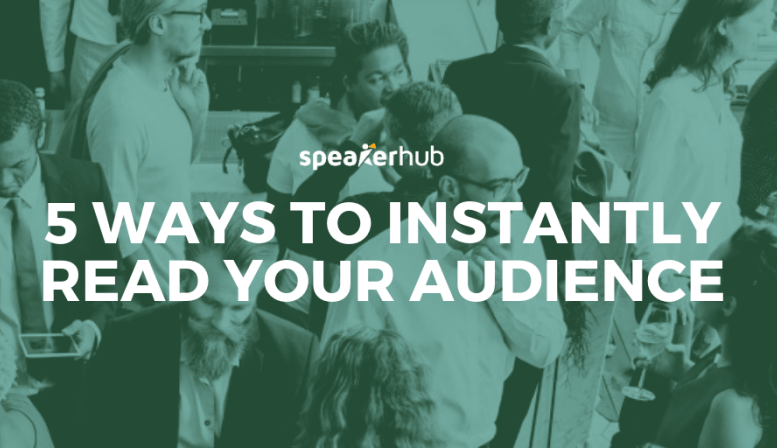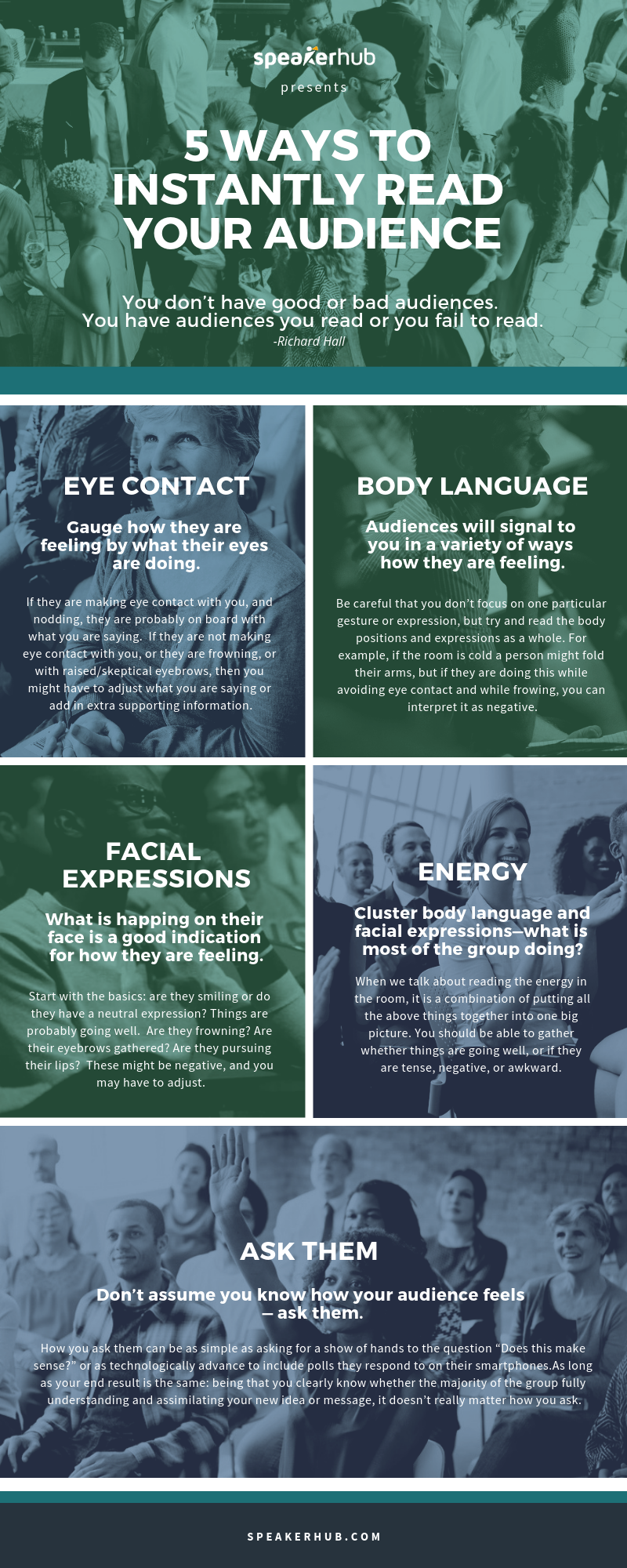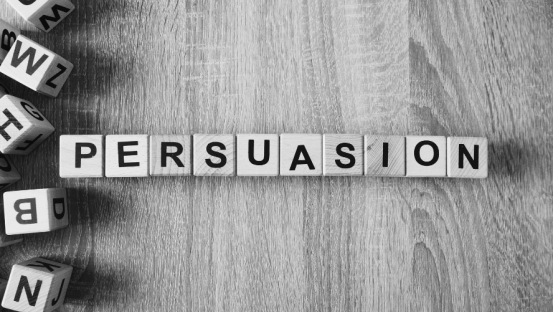5 ways to instantly read your audience

“Taking the pulse of your audience.”
“Analyzing the audience.”
“Feeling out the level of engagement.”
When we use these phrases, we are talking about the same thing: figuring out whether or not your audience members are paying attention and understand what you are saying.
When we talk with a friend, family member or colleague on a one-on-one basis, communication is fairly easy.
If we need clarification, we ask for it.
If we are bored, we change the subject.
When we tell a joke, we naturally know when to stop laughing and start talking again.
But when we are on stage, in front of a large group, these things can be more difficult.
We need to adapt our ability to interact with our audience. We can do this by analyzing the audience, and then adjusting as needed.
Pro speakers know that it’s crucial to check in with the audience regularly
We were talking to a professional speaker recently who told us that she “checks in” with her audience every 3-4 minutes.
Initially, when I heard this, I assumed she meant that she was asking them every few minutes if they understood what she was saying, which to me felt like a lot of checking in!
When I mentioned this, she explained that she uses a variety of methods to check in, and asking is only one of the tools she has in her box.
She talked about using their facial expressions and body language, behavioral signals and even sensing the energy in the room.
By staying in touch with the audience throughout the whole session, she maintained and sustained their interest and was able to engage them during the whole talk.
We thought this was great advice and wanted to share it with you. Here are some tools you can use to check-in with your audience throughout your session, analyze them, and then adjust accordingly.
Instantly analyze your audience

Eye contact
Making eye contact with your audience has two major benefits.
If the audience sees your eyes scanning their faces, they will immediately feel more engaged with you.
Also, you will be able to gauge how they are feeling by what their eyes are doing.
If they are making eye contact with you, and nodding, they are probably on board with what you are saying.
If they are not making eye contact with you, or they are frowning, or with raised/skeptical eyebrows, then you might have to adjust what you are saying or add in extra supporting information.
Facial expressions
Start with the basics: are they smiling or do they have a neutral expression?
Things are probably going well.
Are they frowning? Are their eyebrows gathered? Are they pursing their lips?
These might be negative, and you may have to adjust.
Be on the lookout for micro expressions such as a glimmer of a smile, quickly raised eyebrows, or even micro frowns, where the lips turn down for a flash, then snap back to neutral.
It is extremely difficult to control your micro expressions, so they can be very helpful in telling whether or not your audience is with you.
Body language
Audiences will signal to you in a variety of ways how they are feeling.
Positive audience body language:
-
Upright or slightly forward-leaning seating position.
-
Slightly friendly facial expression.
-
Gentle nods and shakes of their head as you make your key points.
-
Nodding in agreement, or frowning in thought (not all frowning is negative).
-
Hands clasped together, steepling, or casually laying in their laps.
-
Smiling.
-
Open, receptive body posture.
Negative audience body language
-
Fidgeting with personal belongings like glasses, phones, pens, or hair, etc.
-
Rustling papers, or doodling on a notepad.
-
Looking at a watch or clicking a pen.
-
Leaning back on their chair, or slumped far forward.
-
Whispering or chatting among themselves.
-
Looking at the ceiling, at their phone, or out of a window.
-
Frowning while looking at you, or a hostile facial expression.
-
Arms folded and legs crossed, with the person leaning back (like they are putting distance and barriers between you and them).
Be careful that you don’t focus on one particular gesture or expression, but try and read the body positions and expressions as a whole. For example, if the room is cold a person might fold their arms, but if they are doing this while frowning and avoiding eye contact, you can interpret it as negative.
Make sure you understand the basics of the body language of the culture you are presenting in. For example in some Asian countries it is polite to nod and smile, so they may not fully understand what you are saying even if they seem to be expressing positive body language.
Energy
When we talk about reading the energy in the room, it is a combination of putting all the above things together into one big picture.
Look at the group—are they mostly smiling, sitting upright, making eye contact with you, laughing easily, leaning in, and nodding, occasionally sharing looks with one another? It probably means you’ve got positive energy going on.
Are they mostly slumped backed in their chairs, arms folded, not making eye contact with you, staring at the floor or phones, rolling their eyes, or frowning? You could have some tense or awkward energy going on.
If you’ve got good energy, keep it going. If you sense that their is tension or awkwardness, either try and lighten things up or directly ask how you can change it—which brings us directly into our last tool.
Ask them
This is the most surefire way of finding out if your audience is on board with what you are saying.
Don’t assume you know how your audience feels — ask them.
How you ask them can be as simple as asking for a show of hands to the question “Does this make sense?” or as technologically advanced as including polls they respond to on their smartphones.
As long as your end result is the same — i.e. that you clearly know whether the majority of the group fully understand and are assimilating your new idea or message — it doesn’t really matter how you ask.
Find out more about reading your audience in this article, “How to read your audience in 10 seconds”
Looking for more speaking opportunities? Sign up for SpeakerHub here.






